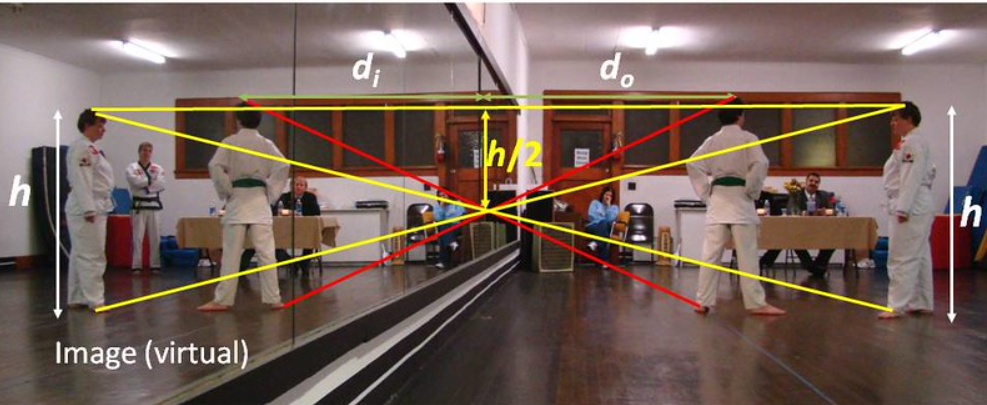
What are the properties of an image formed by a plane mirror?
Answer
476.4k+ views
Hint: : When a light beam contacts a surface, one of three effects can occur: reflection, refraction, or absorption. When it hits a typical surface, the majority of the light is absorbed. Mirrors are polished surfaces that have been coated with mercury to reflect the majority of the light that falls on them. Mirrors can now be classified as concave, convex, or planar mirrors based on their reflecting surface. We shall just discuss the plane mirror in this section. So, to generate a picture, at least two rays from the object must meet or appear to meet at a spot. In the instance of a plane mirror, three pictures were chosen for clarity in the ray diagram shown below.
Complete step by step solution:
The properties of images formed by a plane mirror:
- The image is virtual.
- The image is far behind the mirror as the object is from the mirror.
- The image is laterally inverted.
- The image has the same dimensions as the thing.
- The image is upright (erect).
We can see the person’s (object) image in the mirror in the below figure.

Additional information:
Plane mirrors are used for a variety of purposes, including the following:
They are used as magnifying glasses.
They can also be found in solar cookers.
They are also utilized in the construction of submarine periscopes.
They are also used to create kaleidoscopes, which are toys that produce lovely patterns.
They're also found in a variety of scientific devices.
Note: In a process known as silvering, a plane mirror is created by employing a highly reflective and polished surface, such as silver or aluminum. A small layer of red lead oxide is placed to the back of the mirror after it has been silvered. As long as the reflecting surface is free of tarnishing or oxidation, it will reflect the majority of the light that strikes it. Most current plane mirrors are constructed with a thin sheet of plate glass that protects and reinforces the mirror surface and aids in the prevention of tarnishing. Mirrors were traditionally flat pieces of polished copper, obsidian, brass, or valuable metal.
Complete step by step solution:
The properties of images formed by a plane mirror:
- The image is virtual.
- The image is far behind the mirror as the object is from the mirror.
- The image is laterally inverted.
- The image has the same dimensions as the thing.
- The image is upright (erect).
We can see the person’s (object) image in the mirror in the below figure.

Additional information:
Plane mirrors are used for a variety of purposes, including the following:
They are used as magnifying glasses.
They can also be found in solar cookers.
They are also utilized in the construction of submarine periscopes.
They are also used to create kaleidoscopes, which are toys that produce lovely patterns.
They're also found in a variety of scientific devices.
Note: In a process known as silvering, a plane mirror is created by employing a highly reflective and polished surface, such as silver or aluminum. A small layer of red lead oxide is placed to the back of the mirror after it has been silvered. As long as the reflecting surface is free of tarnishing or oxidation, it will reflect the majority of the light that strikes it. Most current plane mirrors are constructed with a thin sheet of plate glass that protects and reinforces the mirror surface and aids in the prevention of tarnishing. Mirrors were traditionally flat pieces of polished copper, obsidian, brass, or valuable metal.
Recently Updated Pages
Master Class 12 English: Engaging Questions & Answers for Success

Master Class 12 Business Studies: Engaging Questions & Answers for Success

Master Class 12 Economics: Engaging Questions & Answers for Success

Master Class 12 Social Science: Engaging Questions & Answers for Success

Master Class 12 Maths: Engaging Questions & Answers for Success

Master Class 12 Chemistry: Engaging Questions & Answers for Success

Trending doubts
What are the major means of transport Explain each class 12 social science CBSE

Which are the Top 10 Largest Countries of the World?

Draw a labelled sketch of the human eye class 12 physics CBSE

Explain sex determination in humans with line diag class 12 biology CBSE

The pH of the pancreatic juice is A 64 B 86 C 120 D class 12 biology CBSE

Explain sex determination in humans with the help of class 12 biology CBSE




